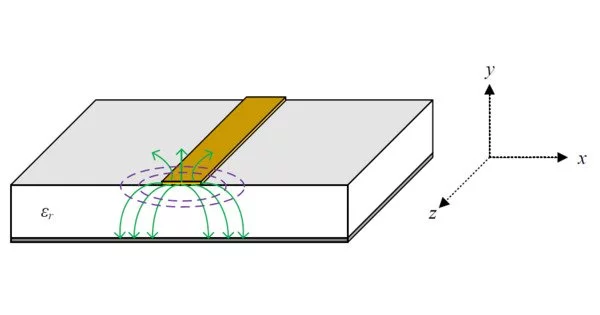A microstrip is a type of electrical transmission line that can be made using any technology in which a conductor is separated from a ground plane by a dielectric layer known as the “substrate.” It is a type of transmission line used in electronics and telecommunications. Microstrip lines are used to transmit microwave signals. It is a planar structure made up of a conducting strip or trace placed on a dielectric substrate and a ground plane on the other side. The transmission line’s conductors are the conducting strip and the ground plane, while the dielectric substrate provides insulation and support.
Typical realization technologies include printed circuit boards (PCBs), alumina coated with a dielectric layer, and, on occasion, silicon or other similar materials. Microwave components such as antennas, couplers, filters, power dividers, and so on can be made of microstrip, with the entire device existing as a metallization pattern on the substrate.
The conducting strip and ground plane in a microstrip configuration are typically made of copper or other highly conductive materials. A thin layer of non-conductive material, such as fiberglass or ceramic, is typically used as the dielectric substrate. The characteristic impedance and electrical properties of the microstrip transmission line are determined by the dimensions of the conducting strip and the dielectric substrate.
As a result, microstrip is much less expensive than traditional waveguide technology, as well as much lighter and more compact. ITT laboratories developed microstrip as a competitor to stripline (first published in the December 1952 IRE proceedings by Grieg and Engelmann).
Because of their small size, ease of fabrication, and compatibility with printed circuit board (PCB) technology, microstrip lines are widely used in high-frequency and microwave applications. They are used for a variety of purposes, including signal transmission, impedance matching, and power and signal distribution on PCBs.
The disadvantages of microstrip over waveguide are lower power handling capacity and higher losses. Furthermore, unlike waveguide, microstrip is typically not enclosed, making it vulnerable to cross-talk and unintentional radiation.
Advantages and Disadvantages
There are advantages and disadvantages to using microstrip lines. Their benefits include small size, low cost, and compatibility with standard PCB manufacturing processes. They also perform well electrically at high frequencies. Microstrip lines, on the other hand, have limitations in terms of power handling capacity and susceptibility to electromagnetic interference (EMI). The dielectric substrate can also introduce losses and affect the overall performance of the transmission line.
Microstrip line design considerations include the desired characteristic impedance, signal propagation speed, substrate dielectric constant, and the dimensions of the conductive trace and the substrate. To model and optimize microstrip designs for specific applications, simulation tools and specialized software are frequently used.
Overall, microstrip lines are an important component in modern electronics and telecommunications systems because they provide a practical and efficient way of transmitting signals and power at high frequencies while maintaining compact form factors.
















